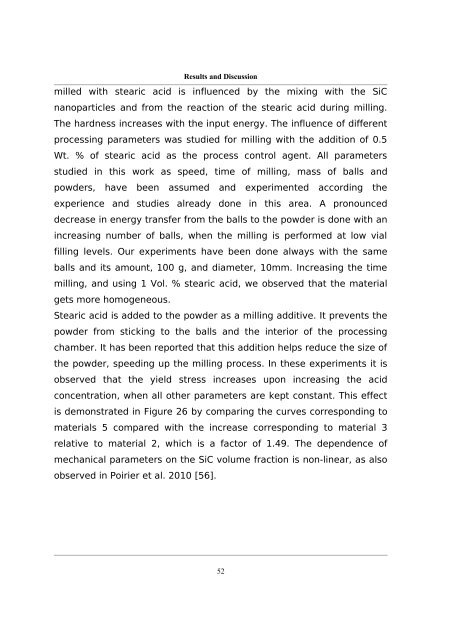Cláudia Sofia de Andrade Redondo Murilhas Buchheim ...
Cláudia Sofia de Andrade Redondo Murilhas Buchheim ...
Cláudia Sofia de Andrade Redondo Murilhas Buchheim ...
Create successful ePaper yourself
Turn your PDF publications into a flip-book with our unique Google optimized e-Paper software.
Results and Discussion<br />
milled with stearic acid is influenced by the mixing with the SiC<br />
nanoparticles and from the reaction of the stearic acid during milling.<br />
The hardness increases with the input energy. The influence of different<br />
processing parameters was studied for milling with the addition of 0.5<br />
Wt. % of stearic acid as the process control agent. All parameters<br />
studied in this work as speed, time of milling, mass of balls and<br />
pow<strong>de</strong>rs, have been assumed and experimented according the<br />
experience and studies already done in this area. A pronounced<br />
<strong>de</strong>crease in energy transfer from the balls to the pow<strong>de</strong>r is done with an<br />
increasing number of balls, when the milling is performed at low vial<br />
filling levels. Our experiments have been done always with the same<br />
balls and its amount, 100 g, and diameter, 10mm. Increasing the time<br />
milling, and using 1 Vol. % stearic acid, we observed that the material<br />
gets more homogeneous.<br />
Stearic acid is ad<strong>de</strong>d to the pow<strong>de</strong>r as a milling additive. It prevents the<br />
pow<strong>de</strong>r from sticking to the balls and the interior of the processing<br />
chamber. It has been reported that this addition helps reduce the size of<br />
the pow<strong>de</strong>r, speeding up the milling process. In these experiments it is<br />
observed that the yield stress increases upon increasing the acid<br />
concentration, when all other parameters are kept constant. This effect<br />
is <strong>de</strong>monstrated in Figure 26 by comparing the curves corresponding to<br />
materials 5 compared with the increase corresponding to material 3<br />
relative to material 2, which is a factor of 1.49. The <strong>de</strong>pen<strong>de</strong>nce of<br />
mechanical parameters on the SiC volume fraction is non-linear, as also<br />
observed in Poirier et al. 2010 [56].<br />
52
















